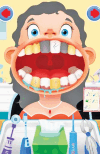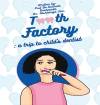Comparative Evaluation of Behavioral and Physiological Outcomes on Dental Anxiety of Children Undergoing Dental Treatment: A Randomized Clinical Trial
- PMID: 40469821
- PMCID: PMC12131057
- DOI: 10.5005/jp-journals-10005-3088
Comparative Evaluation of Behavioral and Physiological Outcomes on Dental Anxiety of Children Undergoing Dental Treatment: A Randomized Clinical Trial
Abstract
Aim: To compare and assess the efficacy of behavior management methods in reducing dental anxiety by using different facial scales and measuring the hemodynamic parameters before, during, and after the dental procedure.
Settings and designs: The present research work was conducted in the Department of Pedodontics and Preventive Dentistry at Sardar Patel Post Graduate Institute of Dental and Medical Sciences, well equipped with the facilities required to assess and compare the level of anxiety in 180 children aged 4-8 years coming for the first time to the dental clinic for restorative dental procedures using three nonpharmacological behavior management techniques in reducing dental anxiety.
Materials and methods: By chit method, the equal sample was subdivided into group I as tell-show-do (TSD), group II as tell-play-do (TPD), group III as tell-read-do (TRD), and group IV as Control (no intervention). Additionally, changes in parameters on the hemodynamic grounds, such as blood pressure, heart rate (HR), or oxygen saturation level, were monitored using picture image scales such as the revised memory and screening-pictorial scale (RMS-PS) and visual pain scale.
Results: Marked reduction in HR, blood pressure, oxygen saturation, and anxiety score were recorded in groups III and II.
Conclusion: Providing information and educating the child prior to the dental treatment using any intervention can cause a marked reduction in the level of anxiety experienced by pediatric patients.
How to cite this article: Giri S, Saha S, Dhinsa K, et al. Comparative Evaluation of Behavioral and Physiological Outcomes on Dental Anxiety of Children Undergoing Dental Treatment: A Randomized Clinical Trial. Int J Clin Pediatr Dent 2025;18(4):383-393.
Keywords: Behavior modification; Blood pressure; Dental anxiety; Heart rate; Oxygen saturation.
Copyright © 2025; The Author(s).
Conflict of interest statement
Source of support: Nil Conflict of interest: NoneConflict of interest: None
Figures







Similar articles
-
Comparative Evaluation of Effectiveness of Tell-Play-Do, Film Modeling and Use of Smartphone Dental Application in the Management of Child Behavior.Int J Clin Pediatr Dent. 2020 Nov-Dec;13(6):682-687. doi: 10.5005/jp-journals-10005-1857. Int J Clin Pediatr Dent. 2020. PMID: 33976496 Free PMC article.
-
A Comparative Study of the CARD™ System and Tell-show-do Technique in the Behavior Management of 6-10-year-old Children.Int J Clin Pediatr Dent. 2025 Jan;18(1):53-57. doi: 10.5005/jp-journals-10005-3023. Epub 2025 Feb 14. Int J Clin Pediatr Dent. 2025. PMID: 40110456 Free PMC article.
-
Comparative Evaluation of the Efficacy of Virtual Reality Distraction, Audio Distraction and Tell-show-do Techniques in Reducing the Anxiety Level of Pediatric Dental Patients: An In Vivo Study.Int J Clin Pediatr Dent. 2021;14(Suppl 2):S173-S178. doi: 10.5005/jp-journals-10005-2106. Int J Clin Pediatr Dent. 2021. PMID: 35645488 Free PMC article.
-
Comparative Evaluation of Acupressure, Aromatherapy, and Stress Ball Efficacy in Reduction of Anxiety Levels in Children during Prophylactic and Restorative Procedures.Int J Clin Pediatr Dent. 2025 Feb;18(2):210-214. doi: 10.5005/jp-journals-10005-3070. Epub 2025 Mar 20. Int J Clin Pediatr Dent. 2025. PMID: 40417433 Free PMC article.
-
Evaluation of Effect of Distraction Techniques Using Virtual Reality and Eight-dimension Audio Analgesia Methods on Pain Perception and Anxiety Levels in Children During Restorative Procedures: A Comparative In Vivo Study.Int J Clin Pediatr Dent. 2024 Oct;17(10):1087-1092. doi: 10.5005/jp-journals-10005-2960. Int J Clin Pediatr Dent. 2024. PMID: 39650306 Free PMC article.
References
-
- Elicherla SR, Bandi S, Nuvvula S, et al. Comparative evaluation of the effectiveness of a mobile app (Little Lovely Dentist) and the tell-show-do technique in the management of dental anxiety and fear: a randomized controlled trial. J Dent Anesth Pain Med. 2019;19(6):369–378. doi: 10.17245/jdapm.2019.19.6.369. - DOI - PMC - PubMed
-
- Khandelwal D, Kalra N, Tyagi R, et al. Control of anxiety in pediatric patients using “Tell Show Do” method and audiovisual distraction. J Contemp Dent Pract. 2018;19(9):1058–1064. - PubMed
-
- Sharma K, Malik M, Sachdev V. Relative efficacy of Tell-Show-Do and live modeling techniques on suburban Indian children during dental treatment based on heart rate values: a clinical study. J Dent Specialities. 2016;4(2):178–182. doi: 10.18231/2393-9834.2016.0016. - DOI
-
- Shah U, Bhatia R. Effectiveness of audiovisual distraction eyeglass method compared to Tell-Play-do technique among 4-7-year-old children: a randomized controlled trial. Int J Oral Care Res. 2018;6(2):1–7.
LinkOut - more resources
Full Text Sources
